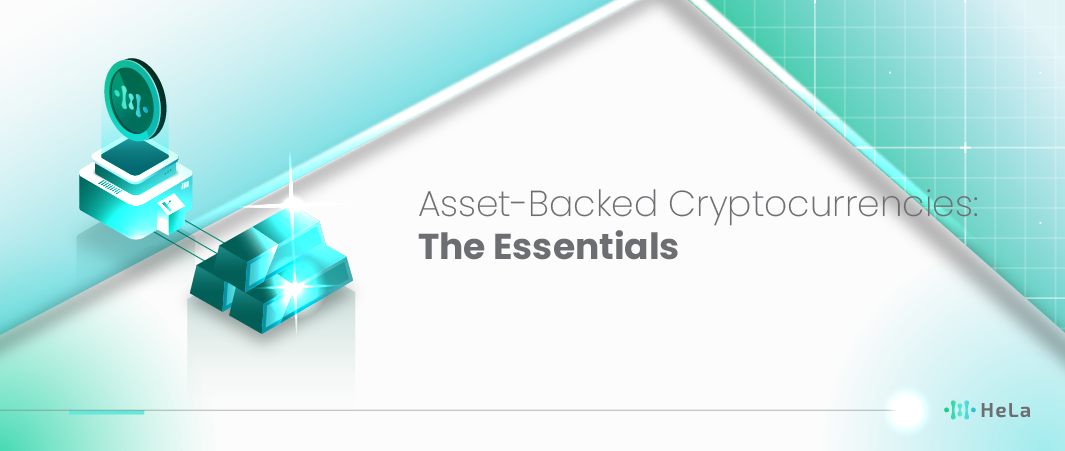In this article, we will delve into the mechanics of asset-backed cryptocurrencies, exploring how they function and examining real-world examples like Tether (USDT), Digix Gold (DGX), and others. We’ll uncover the key factors to consider when choosing an asset-backed crypto, such as issuer credibility, transparency, and liquidity.
By understanding these concepts, you’ll gain valuable insights into how these digital assets can serve as a stable and secure investment, bridging the gap between traditional finance and the digital economy. Dive in to discover how asset-backed crypto could enhance your investment strategy and offer new opportunities in the evolving crypto landscape.
What are asset-backed crypto? How does it work? Asset-backed cryptocurrencies are a class of digital tokens designed to provide stability by anchoring their value to real-world assets like fiat currencies, precious metals, or other tangible items. Unlike highly volatile cryptocurrencies such as Bitcoin or Ethereum, asset-backed cryptos aim to maintain a steady value by being directly supported by physical assets.
This innovative approach combines the benefits of digital assets with the stability of traditional financial instruments, making them an attractive option for investors seeking reliability in the often unpredictable world of cryptocurrencies.
What is an Asset-Backed Crypto?

Asset-backed crypto is a type of crypto-currency which is securitized by physical commodities such as gold, immovable properties, or other world currencies. The price of virtual currencies floats on the digital market with no reference to other currencies, whereas asset-back haircut is more tied with the physical asset that backs it. This creates more security and credibility for the investors since they are assured the underlying asset will back up the coin. Examples of asset-backed crypto include stablecoins backed by the US dollars or even precious metals like gold.
One of the major benefits of asset-backed crypto is that it is highly stable. Because it is linked to real assets, risk, which is usually an attribute to cryptocurrencies such as Bitcoin and Ethereum is characterized by high fluctuation in price cannot be associated with other cryptocurrencies. This makes it more preferable to investors as a hedge on extreme market volatility. Secondly, asset-backed crypto can also act as a form of valuable store, as can gold or real estate but with the added functionality of being quickly negotiable or transferred online.
Nonetheless, there are certain disadvantages and threats that are typical for asset-backed crypto. One of the major challenges has to do with confirming and validating the reserve of the assets that underlie the coin. If these reserves are inadequately managed or if there are issues of opacity, then the public may lose confidence in the coin. For example, there is also the possibility of the assets for which the actual coin was issued to be worth less which will in turn also mean that the value of the coin will go down. Thus, proponents of asset-backed crypto emphasize the importance of trust and transparency in such project’s development.
In the long run, asset-backed crypto could prove beneficial to the overall development of the crypto market. They could potentially appeal to institutional and retail investors who might be wary of investing in crypto due to volatility by offering stability and value protection. They could also act as intermediaries between conventional banking and the blockchain domain, enabling users to leverage the technology without compromising on the tangible assets.
How Does Asset-Backed Crypto Works?
Asset-backed crypto works by linking the value of a cryptocurrency to a physical asset or group of assets, which provides the coin with a stable value. This process typically involves creating digital tokens that represent ownership of the underlying asset. For example, a token might be tied to a specific quantity of gold, real estate, or fiat currency. These tokens can then be traded or used in transactions, much like any other cryptocurrency, but with the added assurance that their value is backed by something tangible.
The underlying assets are usually held in a reserve, often managed by a trusted third party like a financial institution or a custodial service. This reserve acts as collateral to back the tokens in circulation. For instance, in the case of a gold-backed cryptocurrency, the issuer would hold a certain amount of gold in a vault, and each token would represent a fractional ownership of that gold. This system ensures that, theoretically, holders of the token could redeem it for the equivalent amount of the physical asset.
Also Read: Top 10 Crypto Asset Management Companies in 2024
One key element in the operation of asset-backed crypto is transparency and verification. To maintain trust, issuers must provide regular proof that the assets backing the tokens actually exist and are being properly managed. This often involves audits or on-chain mechanisms that allow the public to verify the backing assets. In some cases, smart contracts are used to automate the management of these reserves, ensuring that the backing is always accurate and that the tokens are redeemable at any time.
Despite its advantages, asset-backed crypto still faces certain risks. The value of the underlying assets can fluctuate, which could affect the stability of the token. Moreover, there is a reliance on the issuer or custodian to properly manage and safeguard the reserves. If something goes wrong, such as mismanagement or fraud, the value of the asset-backed crypto could collapse. Thus, trust in the issuer and the mechanisms for verifying the backing assets is crucial for the system to work effectively.
Examples of Asset-Backed Cryptocurrencies

Asset-Backed Cryptocurrencies (ABCs) are digital assets whose value is linked to real-world assets, such as commodities, real estate, or fiat currencies. These tokens aim to provide stability, transparency, and real-world value to the cryptocurrency market. Below are examples of different types of asset-backed cryptocurrencies that illustrate the variety in this field:
Tether (USDT)
Tether is one of the most well-known examples of asset-backed cryptocurrencies. It’s a stablecoin that is pegged to the value of the U.S. dollar, meaning that each USDT token is supposed to be backed by a reserve of actual U.S. dollars or equivalent assets.
This asset backing is intended to maintain a stable value, making Tether less volatile than other cryptocurrencies like Bitcoin or Ethereum. Tether is widely used in the crypto market for trading and as a means of transferring funds between exchanges. However, Tether has faced scrutiny over its transparency and the actual reserves backing its tokens.
Paxos Standard (PAX) and Binance USD (BUSD)
Both Paxos Standard (PAX) and Binance USD (BUSD) are stablecoins backed by the U.S. dollar. PAX was launched by Paxos, a regulated financial institution, and each PAX token is backed by one U.S. dollar held in reserve.
Similarly, BUSD is issued by Paxos in partnership with Binance, one of the largest cryptocurrency exchanges. These stablecoins are designed to provide stability and regulatory oversight, offering users a safe haven in times of market volatility. They are often used for trading and as a medium of exchange in the DeFi ecosystem.
Digix Gold (DGX)
Digix Gold is a cryptocurrency that is backed by physical gold. Each DGX token represents one gram of gold, and the gold is stored in vaults, audited and verified regularly to ensure that the backing is real.
Digix Gold provides an opportunity for investors to hold gold in a digital form, combining the traditional value of gold with the benefits of blockchain technology. The idea is to offer the stability and security of gold while allowing for the liquidity and transferability that comes with digital assets.
Synthetix (sUSD and sBTC)
Synthetix operates on a decentralized platform that facilitates the creation of synthetic assets. These are digital assets that track the value of real-world assets, such as sUSD (synthetic USD) and sBTC (synthetic Bitcoin).
Unlike traditional asset-backed cryptocurrencies, these synthetic assets are not directly backed by physical assets but by a pool of collateral in the form of the platform’s native token, SNX. This setup allows users to gain exposure to the value of real-world assets without owning them directly. Synthetix’s model provides a flexible and innovative way to interact with various asset values through blockchain technology.
Advantages of Asset-Backed Cryptocurrencies
Asset-backed cryptocurrencies have emerged as a unique class of digital assets, offering a blend of traditional finance and modern blockchain technology. Unlike speculative cryptocurrencies, asset-backed tokens derive their value from real-world assets, such as fiat currencies, commodities, or other tangible holdings. This connection to physical or financial assets provides several advantages of Asset-backed cryptocurrencies:
Stability and Reduced Volatility
One of the primary advantages of asset-backed cryptocurrencies is their stability compared to traditional cryptocurrencies like Bitcoin and Ethereum. By being pegged to tangible assets such as fiat currencies, commodities, or real estate, asset-backed cryptocurrencies experience less volatility.
This stability makes them attractive for users seeking a safer alternative to volatile crypto markets, especially in cases where predictability in value is essential, such as payments, remittances, or savings. Stablecoins like Tether (USDT) and Binance USD (BUSD), for instance, maintain a stable value by being backed by U.S. dollars, providing a reliable medium of exchange and a store of value.
Security and Transparency
Asset-backed cryptocurrencies often come with increased security due to the underlying asset’s presence. These assets act as collateral, providing users with a degree of confidence that the cryptocurrency is not just speculative but is backed by real-world value.
Additionally, many issuers of asset-backed cryptocurrencies undergo regular audits and publish reports on their reserves, adding a layer of transparency. For example, Digix Gold (DGX) tokens are backed by physical gold stored in secure vaults, and the company regularly audits and verifies the gold reserves. This level of transparency helps build trust in the asset’s value and backing.
Liquidity and Accessibility
Asset-backed cryptocurrencies enhance liquidity by digitizing real-world assets, making them more accessible to a broader audience. Traditionally, assets like gold or real estate may be difficult to trade or transfer, but by tokenizing these assets, asset-backed cryptocurrencies offer fractional ownership and enable faster transactions.
This democratizes access to investment opportunities that were once limited to larger institutional investors. For instance, Paxos Gold (PAXG) allows users to own and trade small amounts of gold in a digital form, offering the liquidity benefits of cryptocurrencies while retaining the intrinsic value of gold.
Hedging Against Market Risks
Asset-backed cryptocurrencies provide a way to hedge against risks associated with the broader cryptocurrency market. During periods of high volatility or market downturns, investors often seek refuge in stable assets. Asset-backed cryptocurrencies like stablecoins allow investors to preserve value by converting volatile digital assets into stable ones without needing to exit the crypto ecosystem entirely.
This can be particularly beneficial for traders and DeFi users who need a safe haven while continuing to participate in the crypto space. Moreover, asset-backed cryptocurrencies can offer diversification, as they expose users to a range of underlying assets, from fiat to commodities, further mitigating risks.
How to Pick the Best Asset-Backed Crypto?

Selecting the best asset-backed crypto involves the consideration of some factors that will enable one to get the best and an investment that will be secure to meet one’s objectives. The first and most important step is to evaluate the real asset in the background of the cryptocurrency. Hence, various asset-backed cryptos are backed by different types of underlying assets including precious metals like gold or silver, real estates, or fiat currencies. Determine which of the types of assets you need can effectively fit your risk profile and the overall investment plan. For instance, gold-synthesized virtual notes could interest those seeking stability, and real estate tokens could attract those interested in tangible value in property.
Secondly, one must consider the reliability and transparency of the issuer or platform offering the asset-backed crypto. Reliability of the issuer is important because they are the ones who own and control the assets backing up the securities. Search for services that offer real-time or at least frequent, accurate statements of the reserves, or independent reviews thereof or on-chain data. This protects the investors since it confirms the existence and proper management of the actual assets that underpin the digital tokens. However, other factors one should note include the past performance of the issuer in question, their reputation and if the issuer is approved by the appropriate authorities. If the issuer of the bond is reliable and has high transparency, then the safer the investment you are likely to make.
Also Read: What Is Asset Tokenization? A Guide for Beginners
Liquidity is another essential factor when selecting the best asset-backed crypto. You want to choose a token that is easily tradable in the market. High liquidity ensures that you can buy and sell your tokens without significant price fluctuations. Research whether the asset-backed crypto is listed on reputable exchanges and how easy it is to convert your tokens back into the underlying asset or into fiat currency. Tokens that are listed on major exchanges and have strong trading volumes typically offer better liquidity and flexibility for investors.
Lastly, consider the costs and fees associated with the asset-backed crypto. Different platforms have varying fee structures, including transaction fees, redemption fees, and storage costs for the underlying assets. Understanding these costs is crucial because they can affect the overall profitability of your investment. Compare the fee structures of different platforms to find the one that offers the best value for your specific needs. By carefully analyzing these aspects, you can make an informed decision and choose the asset-backed crypto that aligns with your financial objectives.
Conclusion
What are asset-backed crypto? How does it work? Asset-backed cryptocurrencies are digital tokens that derive their value from real-world assets like fiat currencies, precious metals, or other tangible items. These cryptocurrencies are designed to offer stability by linking their value to a physical asset, thus providing a safeguard against the high volatility typically associated with cryptocurrencies like Bitcoin or Ethereum. By maintaining reserves of the underlying asset, these tokens aim to offer a more reliable store of value and a stable medium of exchange. Examples include Tether (USDT), which is pegged to the U.S. dollar, and Digix Gold (DGX), which is backed by physical gold.
Understanding how asset-backed crypto works involves recognizing the mechanisms of asset backing, transparency, and management. Issuers of these tokens are responsible for holding and managing the reserves, with transparency and regular audits being crucial for maintaining trust. For example, stablecoins like Paxos Standard (PAX) and Binance USD (BUSD) are backed by U.S. dollars and aim to provide regulatory oversight and stability. On the other hand, platforms like Synthetix offer synthetic assets that are backed by collateral rather than physical assets. Each type of asset-backed crypto serves different purposes and caters to various needs within the financial ecosystem, from trading and hedging to providing a stable store of value.
Disclaimer: The information provided by HeLa Labs in this article is intended for general informational purposes and does not reflect the company’s opinion. It is not intended as investment advice or a recommendation. Readers are strongly advised to conduct their own thorough research and consult with a qualified financial advisor before making any financial decisions.

In the role of a Hela writer, I weave stories that reveal the core of this revolutionary Layer-1 solution. Created in partnership with accomplished engineers, scientists, and A*STAR IHPC, Hela is tailored for real-world use
- Alifia Berizkyhttps://helalabs.com/blog/author/alifiabm/
- Alifia Berizkyhttps://helalabs.com/blog/author/alifiabm/
- Alifia Berizkyhttps://helalabs.com/blog/author/alifiabm/
- Alifia Berizkyhttps://helalabs.com/blog/author/alifiabm/

